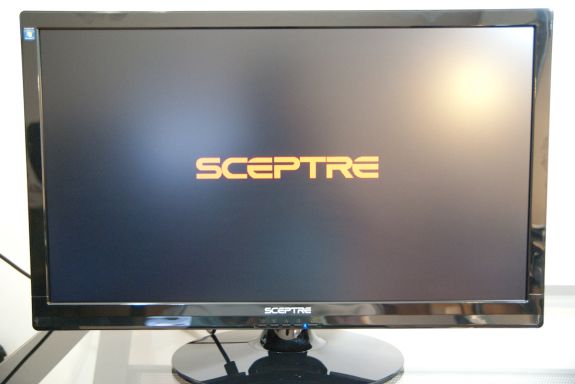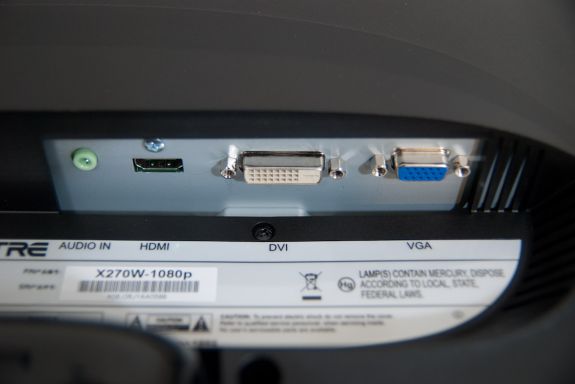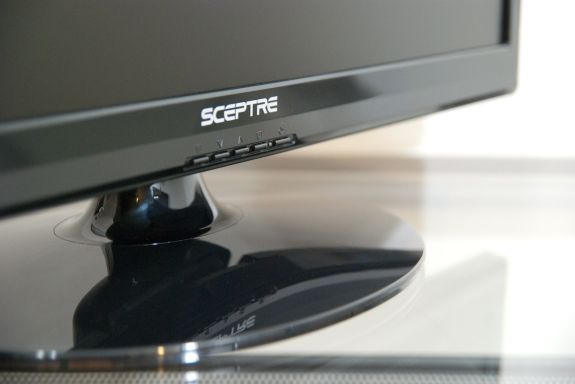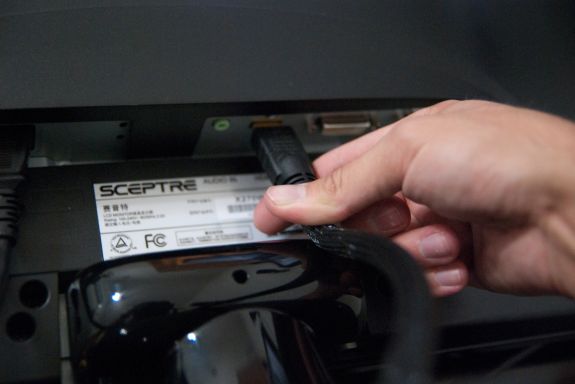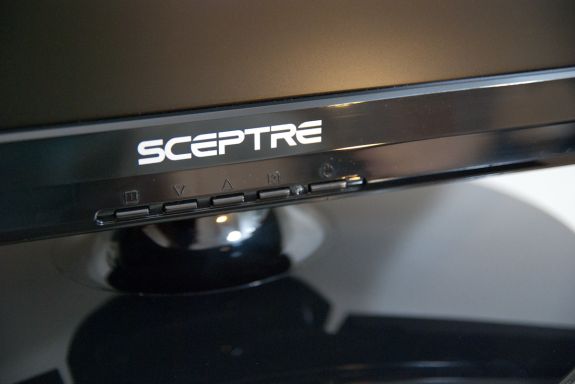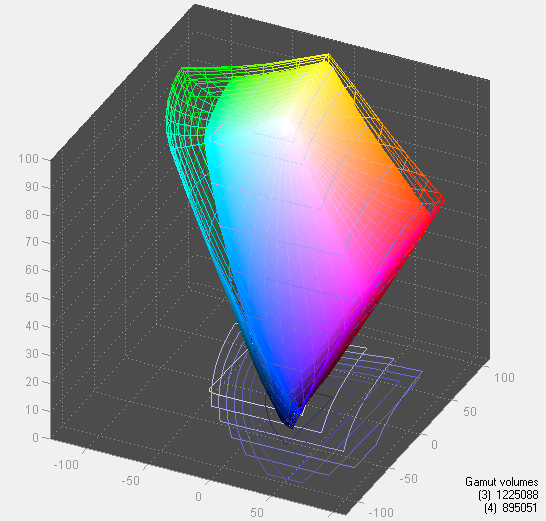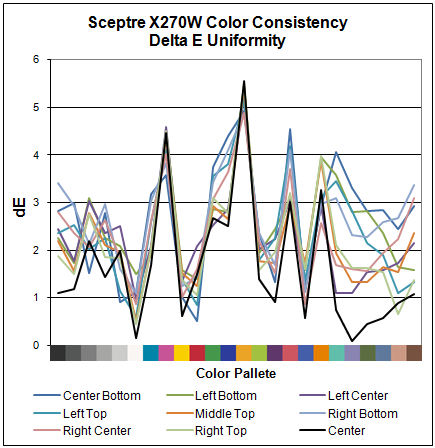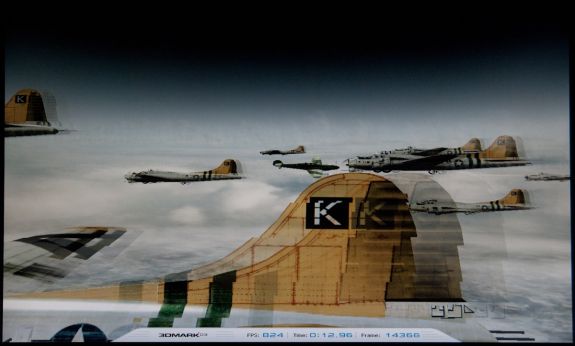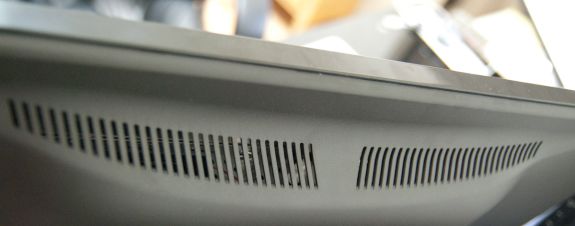
Original Link: https://www.anandtech.com/show/3728/sceptre-x270w-1080p-review-value-27-that-delivers
Sceptre X270W-1080P Review: A Value 27" That Delivers
by Brian Klug on May 17, 2010 10:22 PM ESTSceptre’s 27” X270W-1080P LCD is targeted primarily at PC gamers and desktop productivity segments of the market. To that extent, it packs a TN panel for higher refresh rate and lower processing lag (we’ve shown in previous tests that, for whatever reason, S-PVA panels show a significant amount of input lag), and for meeting that relatively low price point. There are caveats we’ve repeated time and time over about the TN choice, but it actually makes sense here; Sceptre wants a fast panel for gamers that likely don’t care about super accurate color tracking, and they want it to meet gamers’ budgets.
The X270W-1080P, as you’ve probably guessed already, is 1080P. At this size, we’ve got a slightly bigger pixel pitch than we’re used to seeing at 0.311 mm, but in practice it isn’t all that disturbing. In fact, a quick survey of the 27” class of monitors available as of this writing reveals that nearly all are 1920x1080. The 27” class of monitors are an odd bunch size and price wise - sitting in-between 24” and 30” displays. Jumping up to 30” brings you into a market populated with $1200 offerings with all the trimmings. In fact, the X270W’s primary competition is the Hanns•G HH-281HPB 28” LCD which sits at a similar $300 price point.
Anyhow, let’s dive into the specifications:
| Sceptre X270W-1080P - Specifications | |||
| Property | Quoted Specification | ||
| Video Inputs | DVI-D with HDCP, VGA, HDMI, Audio In (3.5 mm) | ||
| Panel Type | TN (Unknown Panel) | ||
| Pixel Pitch | 0.311mm | ||
| Colors | 16.7 million colors | ||
| Brightness | 400 nits typical | ||
| Contrast Ratio |
1000:1 advertised 60000:1 Dynamic advertised |
||
| Response Time | 2ms typical | ||
| Viewable Size | 27" diagonal | ||
| Resolution | 1920x1080 (1080P) 16:9 aspect ratio | ||
| Viewing Angle | 170 degrees horizontal, 160 degrees vertical | ||
| Power Consumption (operation) | <55 watts | ||
| Power Consumption (standby) | <1 watt | ||
| Screen Treatment | Matte (anti-glare) | ||
| Height-Adjustable | No | ||
| Tilt | Yes | ||
| Pivot | No | ||
| Swivel | No | ||
| VESA Wall Mounting | Yes - 100x100mm | ||
| Dimensions w/ Base (WxHxD) | 25.5" x 17.9" x 9.43" (WxHxD) | ||
| Weight w/o Stand | 18.7 lbs | ||
| Additional Features | Built in speakers - 3 watts per channel, kensington security port, Energy Star V.5 | ||
| Limited Warranty | 1-year limited warranty (parts and labor) | ||
| Accessories | DVI, VGA, and power cables | ||
| Price | $399.99 MSR | ||
The X270W packs an above average selection of ports: DVI-D with HDCP, VGA, and HDMI, the latter of which is hugely important for a gaming display so users can switch between PC and a console.
Interestingly, the X270W also packs two internal speakers rated at 3 watts per channel, but doesn’t provide any audio out options for HDMI inputs. That’s a marginal omission - arguably Xbox 360 and PS3 users alike can send audio out over optical TOSLINK to a reciever, or over analog 2 channel by using an adapter, but it’d be nice to see the option for versatility sake. Especially since there’s obviously that hardware onboard for stereo audio to work in the first place.
Appearances and Impressions
Out of box, the Sceptre is imposing (though not so much that you’d want to use it as an ornamental staff). That said, there’s no arguing that 27” isn’t monstrous for an LCD display. Packaging is sufficient and of the styrofoam kind - extracting the big panel isn’t a problem, and doesn’t seem to lend itself to being damaged easily.
The display stand is basic - assembly consists of sliding the panel into one piece which then snaps into the circular plastic base. It’s sufficient to hold the display firmly in place, but doesn’t offer any ergonomic options outside of vertical tilt, about 20 degrees is all you get. Keep in mind on a large panel a small amount of tilt feels like a lot because of how much motion there is out at the extreme, but the 20 degrees of travel here lets you get between perfectly vertical, and comfortably tilted upward. There isn’t any height adjustment, swivel, or rotation. The option (tilt) you get is spartan, but the display stand feels firm and works adequately enough that typing on the same desk doesn’t result in some monitor shake starting. That weird kind of monitor tilt resonance can get really annoying, especially on cheaper display stands. There’s a standard 100mm VESA mount, so you can bring your own better stand if you so choose.
Tight Connector Clearance
My only major complaint with the physical design of the Sceptre is that making connectors are given surprisingly little clearance on the back panel. Connecting my relatively chunky dual link DVI cable to the X270W, I had to bend the cable a bit sharply for it to clear the plastic stand. The single link cable supplied in-box has a noticeably smaller connector, so you won’t run into this issue if you use theirs, but be careful if you’ve got some pre-run, fatter DVI-D cables like mine.
Things got a bit worse with the HDMI cables I had on hand, which admittedly have over-engineered cable strain relief and cause all sorts of problems on other displays - these didn’t fit at all and certainly would’ve broken the port inside if I shoved any further. I guess what I’m getting at is that it’d be nice to see a cable management clip or some routing guidance here, and no obstruction preventing you from bringing any cable down and out. At the end of the day, I wound up grabbing some other HDMI cables.
We’ve already talked about the 1080P display resolution and subsequent 16:9 aspect ratio choice. There’s not much to be said other than that 1920x1200 is quickly becoming the exception to the rule, whether you like it or not. For a monitor packing HDMI which will likely be driven at HD resolutions, there’s definitely an argument in favor of 16:9.
The front panel has the OSD controls centered below the Sceptre logo - there are 5 buttons. Four for navigation, one for power. We’ll talk about the OSD menus at the end of the review, but Sceptre’s options are again a bit spartan and just a little confusing - especially for changing volume, but we’ve seen them before.
Power on lag is respectable - from cold boot to 1080P HDMI display in just over 10 seconds. Switching inputs is very fast - nearly instantaneous. The rest of the controls are responsive, though in HDMI mode it does seem like the menus occasionally were a bit slower than over DVI.
Viewing angles are the standard news for a TN panel - very good until you’re viewing the display at an extreme angle. In fact, the only notably bad angle (as with most TNs) is at an extreme negative angle, viewing the monitor from below. Again, that’s to be expected.
All important display quality isn’t perfect out of box, but gets surprisingly good after you calibrate and tune the display’s somewhat outmoded OSD. We did discover one unobtrusive dead pixel, though it seems to come in and out of being a problem.
Overall first impressions are pretty good: The X270W does what it’s supposed to do, and as we’ll see later, does a relatively good job tracking colors and being uniform. It’s a mammoth display, but again dot pitch is a bit bigger than we’re used to.
X270W Color Quality
We’ll start out with the color quality of the X270W. As per usual, we report two metrics: color gamut and color accuracy (Delta E). Color gamut refers to the range of colors the display is able to represent with respect to some color space. In this case, our reference is the AdobeRGB 1998 color space, which is larger than the sRGB color space. So our percentages are reported with respect to this number, and larger is better.
Color accuracy (Delta E) refers to the display’s ability to display the correct color requested by the GPU. The difference between the color represented by the display, and the color requested by the GPU is our Delta E, and lower is better here. In practice, a Delta E under 1.0 is perfect - the chromatic sensitivity of the human eye is not great enough to distinguish a difference. Moving up, a Delta E of 2.0 or less is generally considered fit for use in a professional imaging environment - it isn’t perfect, but it’s hard to gauge the difference. Finally, Delta E of 4.0 and above is considered visible with the human eye. Of course, the big consideration here is frame of reference; unless you have another monitor or some print samples (color checker card) to compare your display with, you probably won’t notice. That is, until you print or view media on another monitor. Then the difference will be very apparent.
As I mentioned in our G2410H review, we’ve updated our display test bench. We’ve deprecated the Monaco Optix XR Pro colorimeter in favor of an Xrite i1D2 since there are no longer up-to-date drivers for modern platforms. We’ve also done testing and verification with a Spyder 3 colorimeter. We’re using the latest version of ColorEyes Display Pro - 1.52.0r32, for both color tracking and brightness testing.
We’re providing data from other display reviews taken with the Monaco Optix XR alongside new data taken with an Xrite i1D2. They’re comparable, but we made a shift in consistency of operator and instrumentation, so the comparison isn’t perfect. It’s close, though.
For these tests, we calibrate the display and try to obtain the best Delta E we can get at both 200 nits and 100 nits (print brightness). We target 6500K and a gamma of 2.2, but sometimes performance is better using the monitor’s native measured whitepoint and gamma. We also take uncalibrated measurements that show performance out of box. For all of these, dynamic contrast is disabled, all the special color modes we can find are set to standard or manual, and tweak accordingly.
So, how does the X270W do? Let’s dive into the charts:
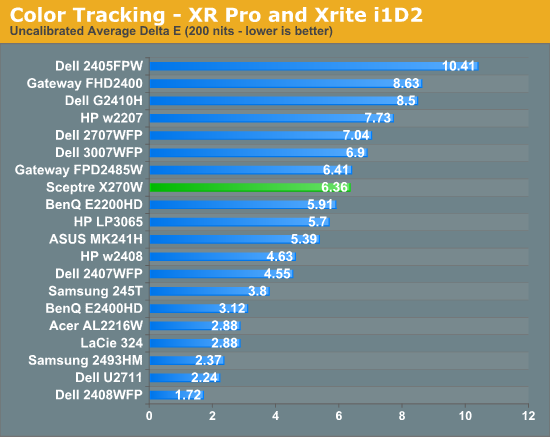
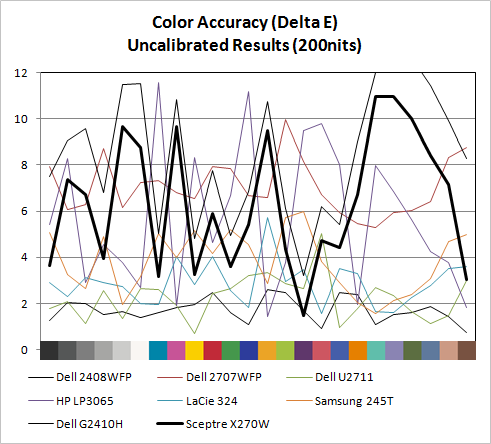
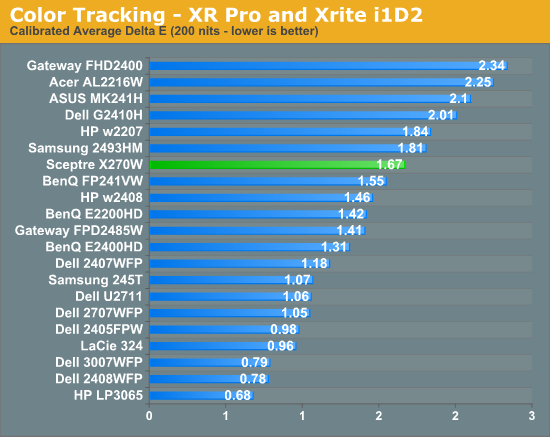
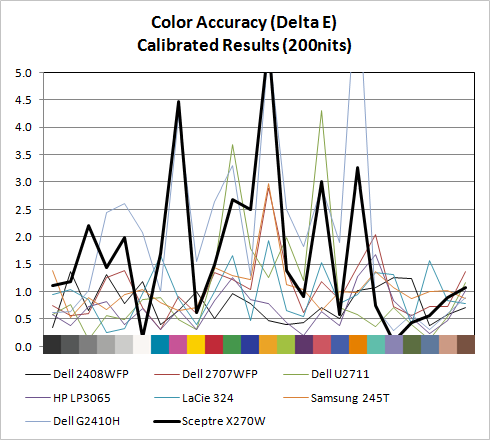
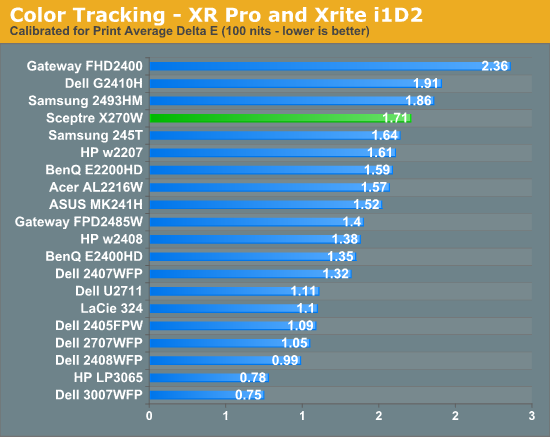
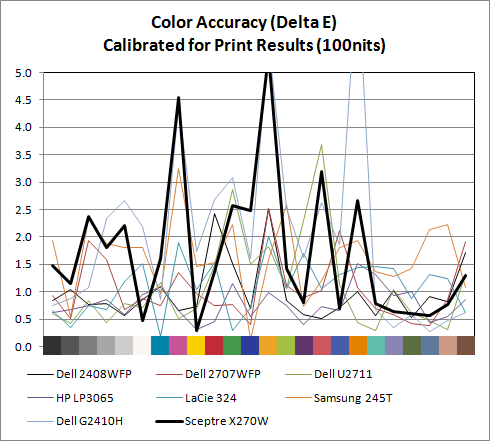
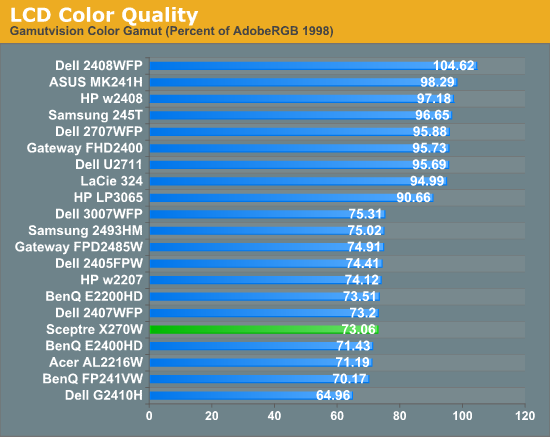
Out of box, the W270W looked a slightly bit blown out and a tiny bit blue next to a few calibrated displays. It isn’t bad, but not perfect - but then again few monitors are perfect out of the box. Uncalibrated X270W performance is very reasonable among some pretty stiff competition in our testbench, at 6.36.
Moving to calibrated performance at 200 nits, the Sceptre actually surprises us with Delta E at 1.67, besting a number of TN panels in our test bench. It’s actually reasonably impressive to see a Delta E of under 2 for this admittedly inexpensive TN. At 100 nits, surprisingly, Delta E actually gets a bit worse, and moves up to 1.72.
Even though both these tracking averages are under 2.0 - and thus technically still good enough to be considered fit for professional use - we’re shooting for perfection here. There are a few notable peaks in Delta E across the color test spectrum that might worry pros. But on the whole, I was pleasantly surprised with how good color tracking is on the X270W.
The X270W has a CCFL backlight, so we get the kind of color gamut volume we’d expect at 73.06%. This is slightly above average performance for a TN panel. For non-image/video editing, a score of 82% equates to the standard Windows sRGB color space and works fine. Overall, for a gaming-focused monitor we’re seeing better color tracking than what’s really needed - and that’s a good thing.
Color Consistency
Building on the 5-point testing we did in the Dell U2711 review, we’ve added testing at 9 different points across the LCD. To test this, we take our best center calibration profile and then test Delta E performance at 9 different places on the display.
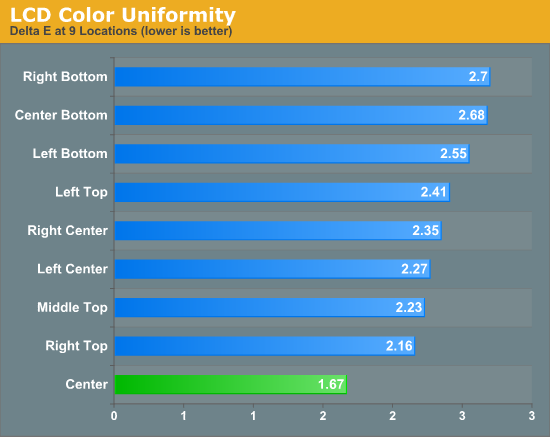
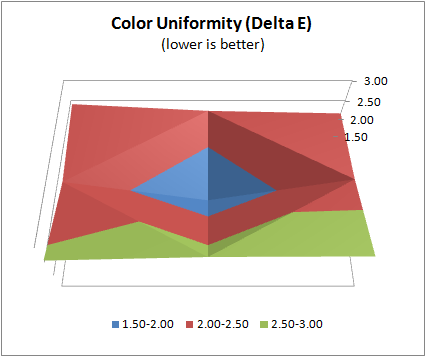
We’ve seen before how localized calibration profiles are on the G2410H, and the X270W is no exception. Performance at other points on the monitor simply differs, and gets on average 0.75 Delta E worse at any given point that isn’t dead center. There’s obviously partially the backlighting uniformity to blame, but we’ll show later that it doesn’t quite match this circular falloff of Delta E performance we’ve measured.
Tracking is reasonably acceptable along the edges, but does average 2.42 as opposed to our relatively stellar 1.67 performance at the center.
Brightness and Contrast
For brightness, black level, and contrast points, we use the same colorimeter setup described earlier. Specifically, an Xrite i1D2 with ColorEyes Display Pro, and take measurements. Dynamic contrast is always turned off, as this throws off our results. We also let the panels settle in for a half hour at the respective settings before taking any measurements. This is especially important for the X270W since it has a CCFL backlight, and as such there is a discernible warm up period.
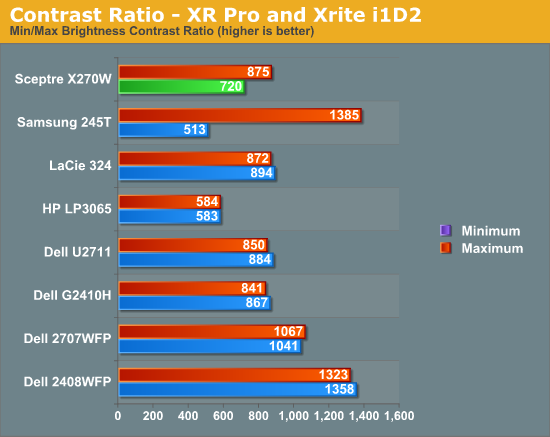
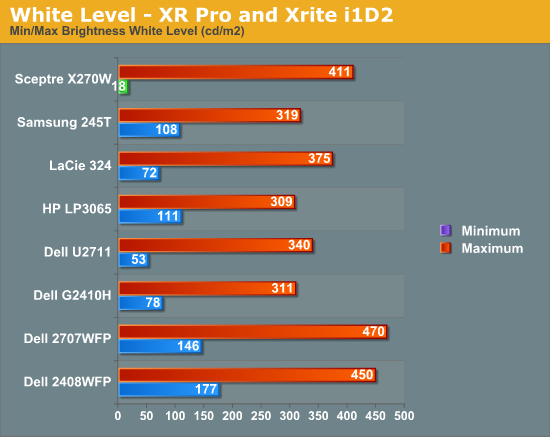
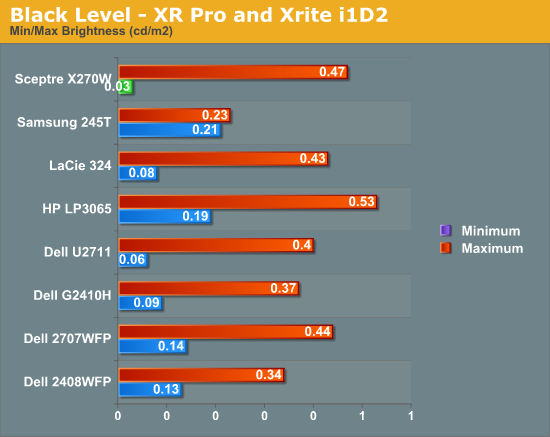
Black level is an important metric, since it directly represents the extinction ratio of the crossed polarizers in the TN cells. Remember, when a pixel is desired to be black, the photoelectric crystal in the cell changes linearly polarized light 90 degrees out of phase, so it is blocked by the polarizer. Higher extinction ratios (and thus better crystals and materials) result in lower (better) black levels.
We recommend running monitors at around 200 nits of luminous intensity, just because this is often where some of the best color tracking sits, and it’s enough of a balance to not result in eye stress from looking around the room and having your pupil adjust. I personally am a bit of a light-crazy person and usually crank my displays brightness to the max (I consider 400 nits normal), but again, forget I ever said that. ;-)
The charts show the dynamic range in brightness, and the respective black levels at each brightness. Brightness isn’t quite up to the 400 nits spec, falling short at 293. This is still pretty bright, but not quite as bright as I’m used to. Again, CCFL isn’t the brightest, but it does give better color gamut than WLED.
What we’re really interested in, however, is the contrast ratio. At the extreme, we fall short of 1000:1 with 720 and 646 at both brightness ends. Respectable, but not stellar.
Update: We were able to get the X270W up past the 400 nit specification by changing contrast to 100% in addition to brightness. At those settings, the brightness for white is 411 nits, and blacks are 0.47 nits. We've updated the graphs above to reflect those changes. Contrast also improved slightly, up from 720 to 875.
Obviously, the X270W can go bright if you set the OSD settings appropriately. Things are more washed out than we'd like with contrast at 100%, but you do get all of those cd/m^2 you pay for, and 11 more.
Brightness Uniformity - White
In addition to the performance a center, we’ve also added 9-point testing for brightness, both white and black. This is done the same way we measure color uniformity, except we only care about measured intensity. We set the monitor through OSD controls as close to 200 nits as possible, and then measured those 9 points.
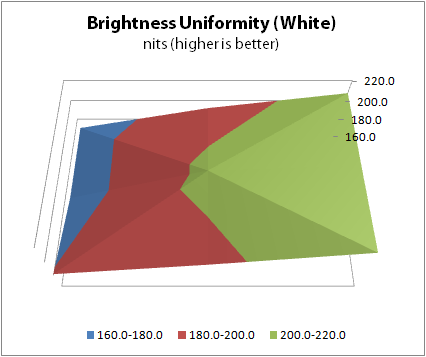
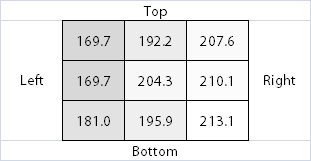
Brightness Uniformity - Black
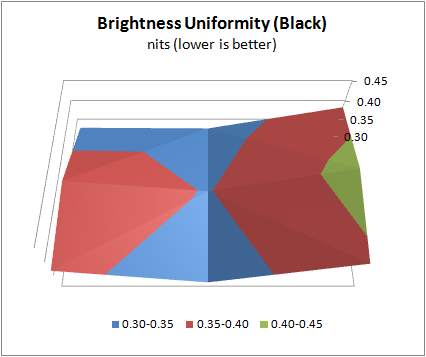
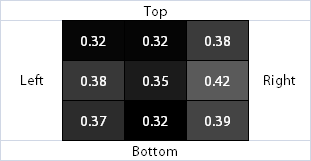
Our plots here do exaggerate differences, but there’s a fairly linear falloff in brightness from right to left across the display as measured. I tested this three times because I couldn’t believe it. Using the monitor, I couldn’t perceive any brightness irregularities at all; it seemed homogenous. If anything, I would’ve said that there was a tiny strip of brightness fall off in the vertical direction, not horizontal, but numbers are numbers. The standard deviation across the monitor here is on the order of 17 nits, for an average of 193.7 nits. It’d be nice to see a bit more uniformity, but it definitely isn’t an issue.
For blacks, there’s a central depression and a bit more brightness at the left and right edges, but then again in practice I never was disturbed nor noticed. Note that the standard deviations here are on the order of 0.035 nits which is pretty darn tiny. Moreover, we’re at respectable black performance to begin with at an average of 0.36.
Display Lag and Response Time
For gamers, display lag is a very real concern, and display processing is a nebulously reported (if at all) specification for just about all LCD displays. Ultimately, what matters isn’t GTG, full on, full off pixel response times, or what’s reported on the spec sheet, but the holistic latency of the monitor compared to something we can all agree is lag-free. We previously used a baseline LCD and compared with it as our benchmark of no display lag - we’ve since started using a 17” Princeton EO700 CRT. It supports 1024x768 at 85 Hz.
To do these tests, we connect the CRT up to a DVI to VGA adapter on our test computer’s ATI Radeon HD5870, and the LCD panel under test to DVI using an HDMI to DVI cable. I debated for some time the merits of using the same VGA signal, however, what really matters here is how the two display methods matter in the way that you, readers, are most likely to set things up. In addition, using the VGA input on any LCD is bound to add additional lag, as this is definitely a hardware scaler operation to go from analog to digital signaling, compared to the entirely digital DVI datapath. We run the CRT at 1024x768 and 85 Hz, its highest refresh rate, and clone the display to the LCD panel.
We use the same 3Dmark03 Wings of Fury benchmark on constant loop, take a bunch of photos with a fast camera (in this case, a Nikon D80 with a 17-50mm F/2.8) with wide open aperture for fast shutter speeds, in this case up to 1/800 of a second. Any differences on the demo clock will be our processing lag, and we’ll still get a good feel for how much pixel response lag there is on the LCD. As I mentioned earlier, the only downside is that this means our old data is no longer a valid reference.
To compute the processing lag, I do two things. First, I watch for differences in the clock between the CRT and LCD, noting these whenever they are visible. I did this for 10 captures of the same sequence. Second, one can compute the processing difference by taking into account the FPS and the frame number difference:
Of course, not every one of those frames is written to the display, but we can still glean how much time difference there is between these respective frames with much more precision than from averaging the time, which only reports down to 1/100ths of a second. An example shot of what this difference looks like on the X270W is the following:

CRT (left) vs. X270W (right) running Wings of Fury in 3Dmark 03
| Processing Lag | ||||
| Display | Averaging Time Difference | FPS Computation Time Difference | ||
| Dell G2410H | 9.0 ms | 8.59 ms | ||
| Sceptre X270W-1080P | 9.0 ms | 5.75 ms | ||
There’s an interesting trend emerging already, and we’ve only got two data points. First off, it’s obvious by now from doing these tests that relying on the time counter at the bottom of the 3Dmark 03 window is relatively unreliable - you either get 10 ms of difference (.01 seconds), or no difference at all. It’s very binary since the processing lag we’re looking for is effectively below our sampling rate, and as a consequence it takes a lot of these points to get data (I averaged 15). On the other hand, it’s very easy to weight the frame difference by FPS and compute the time between, and that tells a different story with greater precision. From those metrics, it’s apparent that the X270W does have lower processing lag than the G2410H. The difference is slight, however, at 2.84 ms - way under what the human eye can perceive - but a difference nonetheless.
We still don’t get near the 2 ms response quoted by Sceptre, but being roughly 6 ms slower than the CRT is pretty darn good, so good that I honestly don’t think it’s humanly possible to tell the difference.
LCD performance still isn’t technically at parity with CRTs, but you’d be hard pressed to tell the difference. There’s still a visible ghosting image before and after the primary frame, visible in the photo above. This is something virtually all the LCDs we’ve tested exhibit, but in practice the ghosting isn’t discernable at all.
I consider myself an avid PC gamer and threw the X270W at FPS, RTS, and RPG titles alike and never noticed ghosting or any perceptible lag, ever. I think it’s more than fair to say that the X270W is a worthy choice for gamers that are generally very discerning about their input lag. By the numbers, the X270W is the best we’ve tested with our new methods thus far, but then again we’ve only got two data points.
Power Consumption
The X270W’s primary focus really isn’t on energy savings, but Sceptre does deliver some surprisingly energy-conscious numbers. We measure power consumption using a Kill-A-Watt EZ at the wall while just displaying the Windows desktop at minimum brightness and maximum brightness.
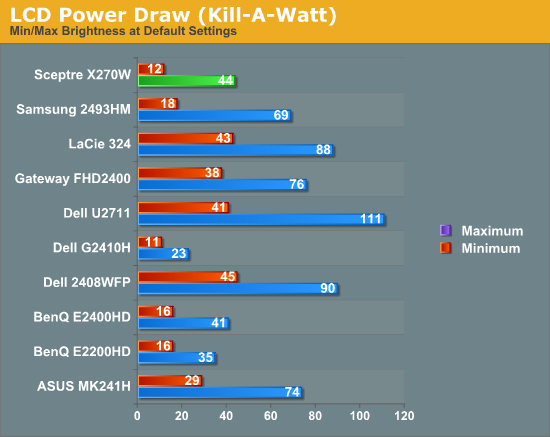
The X270W’s nemesis is, surprisingly, the G2410H. The numbers are impressive, but keep in mind that the G2410H uses 11 watts while pushing a brightness of 78 nits to the Sceptre’s 18 nits. At its brightest, 293 nits, the Sceptre draws 44 watts. By comparison, the G2410H draws 23 watts at 311 nits. Bear in mind the size difference (24” versus 27”) and it’s clear that the X270W’s power per nit performance isn’t shabby at all.
OSD, Speakers, Scaling
The X270W’s OSD is relatively utilitarian. I feel like I’ve seen this OSD style on other monitors as well - there isn’t anything wrong with it, it’s just a bit basic and sometimes cumbersome to get used to [1] being exit and [2] being select, with up and down in-between.
There are settings like you’d expect for contrast, brightness, color temperature, dynamic contrast ratio (DCR), an “Eco mode” that boosts contrast way up and brightness way down, and “opticolor” settings for some presets if you so choose. The full walkthrough is in the gallery below if you’re so inclined.
My only main gripe is that it takes 6-7 button presses to change the volume level on the X270W if you’re using the internal speakers. This is just way too many steps to do something simple, and it’s frustrating. I guess that segues me into the next section.
Speakers
Which is, the speakers. There are two speakers at the top, hidden discretely under the vented slots on the top of the bezel. I’m torn about the inclusion of speakers inside monitors. On one hand, if you’re just using the computer for productivity, it’s nice to have the speakers taken care of, since all you need them for are audio prompts and alerts from the OS. On the other hand, if you’re serious about hearing your game (those ever-telling footsteps) or your music, in-monitor speakers are never ever going to suffice.
I measured the X270W’s speakers using an Extech 407760 USB datalogger in a room with ambient relative noise level of 51 dBA. At 6 inches away, the sound level was 83.5 dBA listening to music at maximum volume on the PC and the monitor. So they go reasonably loud, but the quality leaves much to be desired. It’s a very tinny lifeless sound lacking most of the mid and low frequencies - passable for those OS alerts, but not much more.
The speakers also are default on when using an HDMI connection, albeit even quieter because the HDMI audio is ostensibly normalized. You can watch a movie on them, but hearing quieter dialogue and enjoying the full dynamic range of the audio is obviously far out of the question, and since there aren’t any audio out options, using the monitor with some stereo headsets is also out of the question unless you bring your own HDMI audio splitter.
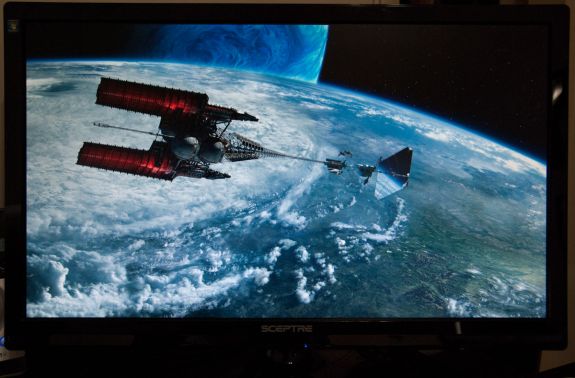
Avatar Blu-Ray over HDMI: Flawless as expected
While we’re on the HDMI port, everything here worked flawelessly. The display works fine with the HDCP chain tested on the desktop and a Samsung Blu-Ray player.
Scaling
Thankfully, the X207W includes options for aspect ratio aware stretching, overscanning, and full screen stretching. We tested a number of different resolutions and were pleased with the output of the aspect-aware stretching as well as full screen stretching. Overscanning could be useful for HDMI input, but in practice just use 1080P and avoid any issues.
Trying 1280x720 did result in black squares along the edges despite aspect aware stretching being selected. It’d be nice to see a 1:1 option, as that currently only truly exists for 1080P inputs at native panel resolution.
Conclusions
I have to admit I initially didn't expect much of the Sceptre X270W in the way of display performance. Having gone through a considerable number of lower-end displays, I've been trained to be skeptical of the cheapest display in any size category, and especially so when dealing with TN panels. As of this writing, the Sceptre X270W-1080P is the cheapest 27” LCD on Newegg at $309.99 - putting it squarely in that category.
I was pleasantly surprised, then, when the Sceptre X270W shattered my preconceptions and demonstrated that you can definitely get decent performance on a budget. Color tracking is relatively impressive for such an inexpensive display, gamut volume is almost right where it should be given the CCFL backlight, and the display is qualitatively uniform when it comes to brightness. The other concerns are nitpicks - you probably won’t use the speakers (honestly you shouldn’t), but they’re nice to have just in case, and while the stand is a bit basic, it does the job without many caveats.
I told Anand about a day or two after I unboxed and started using the X270W on a daily basis that the Sceptre monitor reminded me of Egypt on two counts - it’s huge like the Great Pyramid of Giza, and nearly as grainy due to that pixel pitch. Now that I know that performance and Delta E are actually pretty good, I feel bad saying those things - this is a solid LCD as far as TN panel displays go. Pixel pitch is still a bit large for my taste at 0.311mm, but in all seriousness it doesn’t detract one bit from the performance of the monitor - it’s just a matter of personal taste. Some will like the fact that the .311 pixel pitch is easier on old eyes, for example. When it’s all said and done, if the pharaoh of Egypt really did want a 27” monitor on a budget, the X270W might just have been his Sceptre.

